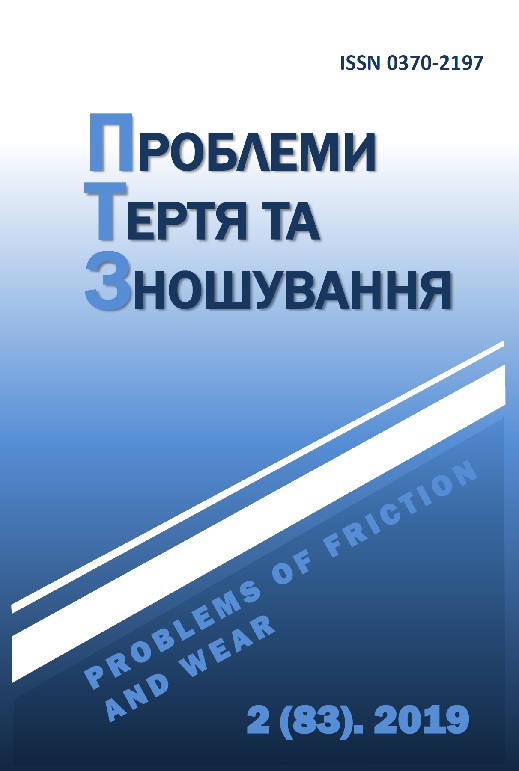INVESTIGATION OF PIPE STEEL COOLING SYSTEMS FOR PERMANENT OPERATIONS IN THE CONDITIONS OF INDUSTRIAL PRODUCTION
DOI:
https://doi.org/10.18372/0370-2197.2(83).13694Keywords:
corrosion, deterioration, crack resistance, viscosity, coolants, stressesAbstract
It is known that in the food and agro-processing industry, cooling systems for the freezing of products are widely used, which are used where direct freezing with the aid of a refrigerant is not desirable. In these cases, most of ten use solutions of sodium chloride, calcium and magnesium, which provide low temperatures (to –50ºС).In addition, cooling systems that contain corrosion-active chlorine ions and oxygen are widely used in industrial and commercial enterprises - refrigerators, ice cream factories, in fermentation, dairy, wine and other branches of the agro-processing industry. For the manufacture of pipelines, ammonia and freon coolers of high and medium productivity, water and spit pipelines, seamless pipes made of carbon steels are used. It has been established that the life of the equipment before the appearance of through holes in pipes or cracks under the influence of refrigeration is 0,5-3 years, while the standard term of cooling systems is 10-12 years. A characteristic feature is the uneven corrosion of pumps, equipment and pipelines, which are operated for a longtime at minus temperatures. As practice shows, the service life of piping systems, including those working in the extreme temperature-baric conditions of food production, is largely determined by the cold resistance of the metal. It is known that the main cause of the low cracking strength of metal pipes at minus temperatures, which are exploited in aggressive environments, is the flooding of the metal, which, in turn, causes a breakdown of the metal through its exfoliation. However, it should be noted that the variability, the large volume of experimental material, and often the uncertainty and contradiction in information regarding the influence of hydrogen on the mechanical characteristics of steels, as well as the lack of evidence base on the change in the crystalline structure and the justification of the effect on the metal stripping necessitates fur the research. The results of experimental and theoretical investigations, which allowed to explain the mechanisms of the reduction of pipestones of cooling systems of long-term operation in conditions of fermentation production, were presented in the work. In particular, it has been found that with increasing lifetime and a decrease in minus temperatures, cooling mixtures bitter increase the value of the strain distortions of the crystal lattice α-matrix. It is shown that with a decrease in temperature from -10 to -50ºC, the parameters of the crystalline lattice are reduced. Using the mathematical apparatus of the dislocation theorem of strength, energy is calculated, which is sufficient for the origin of microcracks in the presence of a catalyst - hydrogen. It has been established that with increasing lifetime the mass fraction of cementite of tubular steels drops sharply, indicating that the material is thickening and deteriorating. It is proved that about 35-30% of carbon atoms of cementite passes through its solution in the α-solid solution in the course of prolonged operation of the pipes of heat exchangers of cooling systems, which leads to a decrease in the strength characteristics of the steel device.
References
Атомный механизм разрушения. – М.:Мир.–1963.–660с.
Гилман Дж. Скол, пластичность и вязкость кристаллов//Атомный механизм ра-зрушения. – М.:Мир.–1963.–660с.
Калачев Б.А. Водородная хрупкость металлов.–М.:Металлургия.–1985.–216 с.
Карпенко Г.В., Крипякевич Р.И. Влияние водорода на свойства стали. – М.:Металлургиздат.–1962.–200c.
Карпенко Г.В., Василенко И.И. Коррозионное растрескивание сталей.-Киев: Техника.–1971.–191с.
Мешков Ю.Я., Пахаренко Г.А. Структура металла и хрупкость стальных изделий. – Киев: Наукова думка. –1985.–266 с.
Литвак И.М. Технология и технологический контроль свеклосахарного производ-ства. –М.: Пищепромиздат. – 1992. – 448с.
Гуревич М.С., Федоров П.Д. Теплосиловое хазяйство сахарных заводов. – Киев. -1992. – 379с.
Ставников В.Н., Баранцев В.И. Процессы и аппараты пищевых производств. – М.: - Пищевая промышленность. – 1984. – 327с.
Сухенко Ю.Г., Литвиненко О.А., Сухенко В.Ю. Надiйнiсть i довговiчнiсть устат-кування харчових i переробних виробництв. – Киiв.- НУХТ. – 2010. – 547с.
PressoureG.М., BlondeauR., CadionL. HSLA steels with inproved hydrogen sulfide cracking resistance // Proc. Conf. Amer. Soc. Metals. – Philadelphia: Ра, 2012. Р. 827-843.
Martynova O.I., Vainman A.B. Einige Probleme der Sauerstoff-fahrweise in Anlagen mit Zwang durch laufkesseln // VGB Kraftwerkstechnik.– 2011.–№8.– S.659–663.
Trucbon M.R., Crolet J.I. Experimental limits of sourer servise for tubular steels //SSC Simposium. – Saint-Cloud.– 21.– 2013 p.
Stardisco J.B,,Pitts R.E. Corrosion of Iron in H2S-CO2-H2O System , Mechanism of Sulfide Film Formation an Kinetics of Corrosion // Corrosion . –2014. –№9. –P.245–253.
Винников Ю.Л., Макаренко В.Д., Кравець І.А., Миненко І.С..Дослідження при-чин зниження міцності трубопроводів ТЕЦ. – Прoблеми тертя та зношування. – 2019. – №1(82). –С.63–68.
Макаренко В.Д., Чеботар І.М., Петренко О.О., Ногіна А.М. Дослідження механі-чних властивостей труб охолоджуючих систем довготривалоï експлуатаціï в широкому інтервалі мінусових температур в умовах бродильного виробництва. – Проблеми тертя та зношування. –2019. –№1(82). – С.69–79.
Лебедев А.А., Бойко А.В. Установка для испытания конструкционных материа-лов на трещиностойкость при двуосном растяжении. – Проблемы прочности. – №8. –С.56–59.
Лебедев А.А., Бойко А.В., Загорняк О.В. Упругопластическое разрушение плас-тин с трещиной. – Физ.-хим. механика материалов. – 1991. – №6. – С.54–57.
Загорняк О.В., Бойко А.В., Лебедев А.А. Предельное состояние пластины с тре-щиной при двухосном растяжении. – Проблемы прочности. – №12. – С.21–26.

